How to Grow & Care for Ornamental Cabbage & Flowering Kale Plant
Written by Ivy
Dec 08 2021
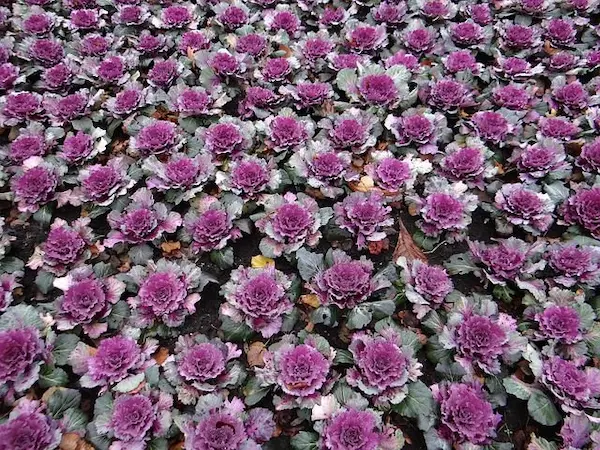
Ornamental cabbage and kale are categorized as the same species (Brassica oleracea) as edible cabbage, broccoli, and cauliflower. They are considered edible but have a very bitter taste–often used as a food garnish.
Potted ornamental cabbage or kale is ideal for garden boxes, pots and other containers. It makes for a perfect addition to terraces and balconies in any region.
Ornamental Cabbage Quick Info
| Botanical/Scientific Name | Brassica Oleracea |
| Common Name | Ornamental Cabbage, Flowering Cabbage |
| Varieties | Osaka Pink Kale, Osaka Red Kale, Coral Prince Kale, Coral Queen Kale, Crane or Pigeon Kale |
| Light Care | Full sun and rich |
| Soil Care | Rather rich and cool soil |
| Temperature Care | 65 to 70 degrees F. (18 to 21 C.) |
| Humidity Care | Moisture Humidity |
| Watering | Keep the plants well-watered |
| Pruning Care | Trim away the lowest leaves when the plants become 6 inches tall |
| Fertilizer Care | Keep the soil moist but not waterlogged as the plants develop |
| Propagation | Be propagated by seed |
When to Plant Decorative Cabbage
You can develop the ornamental cabbage kale or flowering cabbage from seeds. The plant will attain full dimension inside eleven to 14 weeks. You can sow the seeds in late spring or early summertime if you are planning autumn planting. Make sure you sow the seeds at least 6-10 weeks earlier than the first frost. Transplant the seedlings to pots when the first leaves appear. Replant the seedlings until the backside of the cotyledons, if they emerge as leggy. If you are sowing the seeds immediately in the garden, cowl the seeds gently with soil. Keep the soil moist till the seeds are germinated. Fresh seed takes 1 to two weeks for the seeds to germinate. Plant the Ornamental Cabbage seedlings in the backyard by using giving a spacing of 18 to 24 inches. The best time to transplant is when the seedlings attain a peak of 3-4 inches.
When you choose to purchase these flowers for your garden, go for the flora which is large in size. Select plant life with brief stems and having leaves of uniform length. It is higher to decide for plant life which already have an indication of their colour.
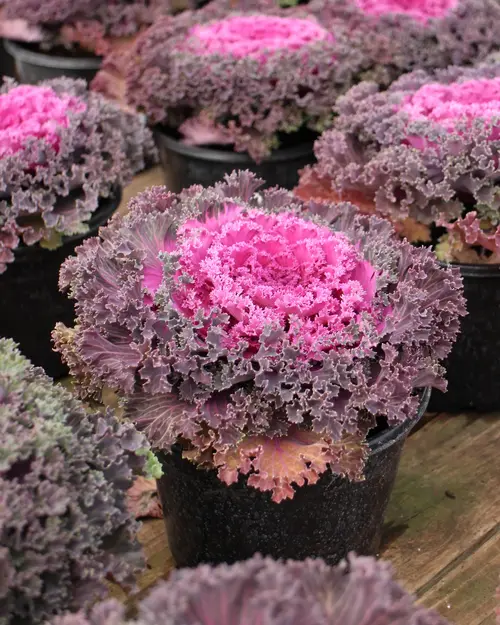
Potted Ornamental Cabbage
How to Care for Ornamental Cabbage
Ornamental Cabbage Watering
Ornamental kale is one of the best cool-weather flora to care for. When you plant it, make positive the root ball is loosened and that you sink the Ornamental Cabbage into the soil till the bottoms of the leaves are flush with the floor or the container lip. Make positive you water the Ornamental Cabbage totally afterwards.For maintenance, let it dry out earlier than watering once more however do no longer lengthen the drought period. They can preserve their splendor in full solar or section sun. They do now not like warm weather, so be certain to plant them solely when the temperatures are constantly cool, as mentioned above.
Soil for Ornamental Cabbage
Ornamental Cabbage is effortlessly grown from seed however have to be began via midsummer to be equipped for fall planting. Light is wanted for germination, so sprinkle seed on developing medium however do now not cowl with soil. Maintain temperature at sixty five to 70 tiers F. (18 to 21 C.) to resource germination. Seedlings have to emerge in four to 6 days. Keep temperature cool at some point of boom period. Site Ornamental Cabbage in full sun, with some afternoon color the place areas are very warm. They decide upon moist, well-drained soil that is quite acidic. Fertilize with a timed-release fertilizer about three weeks after planting or transferring to containers. If summers are too warm for developing seed, you might also choose to buy transplants from the backyard center. Look for top colour and a dimension gorgeous for the favored planting area. Purchased flowering cabbage normally may not develop a lot greater after planting. When the temperature drops, colorations ought to intensify, however. Ornamental cabbage vegetation are susceptible to the equal pests and illnesses as cabbage and kale grown in the garden, however an awful lot much less so given the time of year. If noticed, deal with with fabulous organic controls.Ornamental Cabbage Light Requirements
Ornamental cabbages and kales do now not tolerate summer season heat, so you want to begin Ornamental Cabbage from Ornamental Cabbage seed in mid-summer, or buy transplants at your neighborhood backyard center. Sow seeds about six to 10 weeks before the predicted date of the first frost in your area. Seeds need to be sown and younger vegetation saved underneath cool stipulations to thrive. In most climates, this skill Ornamental Cabbages ought to be commenced in a greenhouse the place the temperature can be controlled. Alternatively, you can region pots with seeds in a fridge for quite a few days to motivate germination. In cooler climates, sowing seeds at once in the backyard might also be possible. Ornamental cabbage and kale seeds require mild for germination, so seeds must now not be blanketed with soil.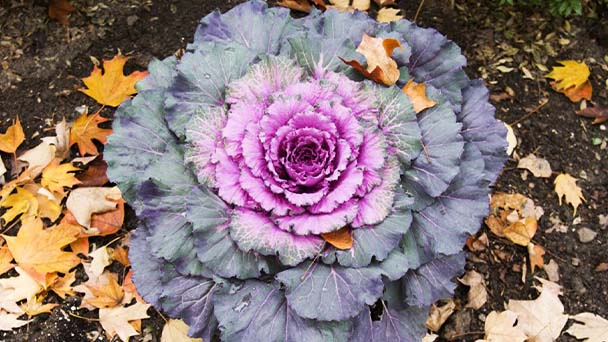
Ornamental Cabbage Temperature Care
Ornamental cabbages and kales do no longer tolerate summer time warmness and Ornamental Cabbages set out in spring will in all likelihood have bolted or declined in appearance, so it is crucial to both begin from seed in mid-summer or buy transplants for a right fall show. Seeds need to be sown and younger flowers saved beneath cool stipulations to thrive, so this is a task first-rate desirable for a greenhouse the place the temperature can be controlled. In cooler areas you may additionally be capable to sow the seeds without delay in the garden. Otherwise, strive setting the pot(s) with seeds in the fridge for various days to inspire germination. The seeds require mild for germination, so do now not cowl them with soil. Sow your seeds about 6-10 weeks earlier than the first frost.Wait till temperatures begin cooling down, then Ornamental Cabbage in a sunny area in a quite moist, prosperous soil. Bury the stem so the lowest leaves are flush with the soil surface. Keep the Ornamental Cabbages nicely watered. Ornamental cabbage and kale are remarkable for changing worn out summer season annuals for a long-lasting fall display. Try to role them the place you will see the colourful centers. Use them in mass plantings, in blended or single container plantings and as edgings. They appear stunning in the the front of a border, in particular when mixed with perennials that are at their height in the fall, such as little bluestem grass (Schizacrium scoparium), tall, dark-leaved sedums or asters. For an handy and fascinating container planting, region an decorative cabbage or kale in the core and pansies round the edge. Or strive them with different plant life that can tolerate mild frosts, such as Swiss chard, snapdragons or petunias.
Ornamental Cabbage Humidity Care
The predominant bugs attacking flowering cabbage and kale consist of the cabbage looper, leaf roller, and aphids. Under immoderate moisture and humid stipulations younger Ornamental Cabbages might also be inclined to downy mildew.Mulch round flowers to assist hold moisture. Although weeds are not a whole lot of a hassle for the duration of cool seasons, mulch will inhibit their growth.
Some of us like to area flowers nearer together. This continues them greater compact, however reduces airflow. The threat right here is that if there is a heat spell, humidity might also construct between vegetation and invite fungal disease.
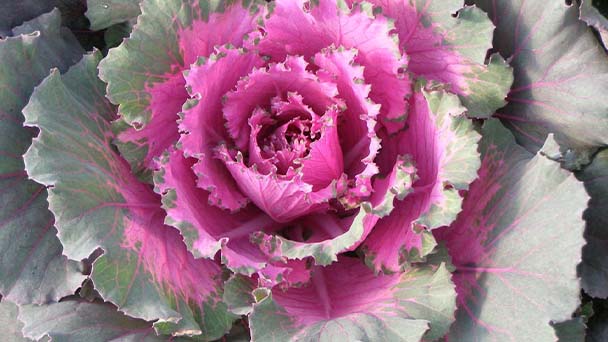
Fertilizer for Ornamental Cabbage
Flowering kale care is exceptionally simple. Rule wide variety 1 is no longer to let the Ornamental Cabbages dry out. They can not stand overly dry prerequisites so they want to be saved nicely watered. Too a good deal fertilizer can intrude with shade and motive stem elongation, so fertilizing kale at planting time need to be enough. Use a balanced fertilizer (ratio 3-1-2 or 1-1-1) with micro-nutrients. Cut off flower stems as quickly as they appear. Pests and ailments are notably tons the equal as these that have an effect on suitable for eating kale and are dealt with accordingly. Now that you be aware of how handy flowering kale care is, you will be capable to seem ahead to your very own show subsequent fall and on into the winter.Keep the soil moist however now not waterlogged as the Ornamental Cabbages develop. University of Minnesota Extension recommends fertilizing kale with a nitrogen-rich fertilizer when the Ornamental Cabbages attain four inches tall. Alternatively, you can aspect costume with compost and water with compost tea weekly to nourish your kale. When the Ornamental Cabbages mature and cooler climate arrives, the shade of the foliage will deepen to the appropriate and ornamental blue-greens, reds and purples.
Monitor the kale for pests, such as caterpillars and cabbageworms. University of California Statewide Integrated Pest Management Program recommends spraying the foliage with a Btk (Bacillus thuringiensis ssp. kurstak) product to put off hungry caterpillars. Alternatively, handpick caterpillars and different pests. Because ailments can be unfold from one 12 months to the next, rotate the region of your Brassicas each season. Avoid planting in the equal vicinity for 4 years.
Whether you are harvesting the leaves for the kitchen or for a bouquet, be positive to sterilize the shears or anvil pruners with rubbing alcohol to keep away from spreading diseases. The small new leaves may also be used in salads, whilst large leaves can be chopped or shredded and boiled or steamed.
Ornamental Cabbage Pruning
Pruning away decorative cabbage flower stalks is the important kind of pruning these lush, low-fuss flora require, in accordance to Arizona State University. Sometimes known as "deadheading," pruning away the flower stalks will assist redirect the Ornamental Cabbage's electricity returned towards its foliage and roots, which will assist it seem to be brisker longer. Its densely packed rosette of leaves is decorative cabbage's most pleasing feature. Its leaves develop in a range of colors, ranging from icy blue to wonderful magenta. The vegetation are of little decorative cost and normally emerge when decorative cabbage is nearing the cease of its lifestyles cycle in a method referred to as "bolting." It commonly occurs throughout instances of stress, such as when the climate warms up.Start with sharp, sanitized pruning shears. Simply push aside the whorl of leaves the place the flower stalk emerges and snip off the stalk at the base. Take care now not to snip off any of the densely packed younger leaves, due to the fact the Ornamental Cabbage's herbal symmetry should be altered. Ornamental cabbages produce solely one flower stalk a season, so pruning as soon as per Ornamental Cabbage is all it is needed.
Ornamental Cabbage Pest & Disease Control
Ornamental cabbage and kale are inclined to a range of bugs and diseases. The most frequent pests, mainly with out of doors production, encompass aphids (Photo 7), caterpillars, flea beetles (Photo 8), whiteflies, slugs and snails (Photo 9). The most frequent illnesses of decorative cabbage and kale encompass Alternaria leaf spot, black rot, membership rot, downy mildew, fusarium yellows, rhizoctonia stem rot and root rots brought on via Pythium and Phytophthora. Therefore, whilst the usage of a substrate that holds enough moisture helps forestall lower-leaf loss, the substrate need to additionally be allowed to dry out rather between irrigation events.How to Grow Ornamental Cabbage
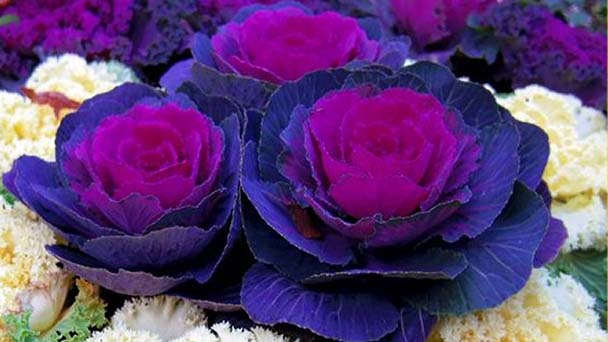
Grow Ornamental Cabbage from seeds
Start ornamental cabbage seeds to create a colourful mattress that is bloodless tolerant and easy-to-maintain. Ornamental Cabbage makes use of encompass edging the flower border or planting in containers for fall and wintry weather interest. These Ornamental Brassica vegetation incorporate all pink, all white, or all red facilities with inexperienced outer leaves. Nothing appears greater stylish or stands out greater fantastically in the fall than Ornamental Brassicas.Just begin Ornamental Brassica seeds indoors, masking the flower seeds very lightly. Ornamental Cabbage seeds germinate rapidly and the younger plant life can be transplanted. Ornamental Cabbage plant life will begin out green, and with time, they will commence to strengthen color. About 12 weeks after sowing the Ornamental Cabbage seeds, there will be a flawlessly round, colourful rosette 10 inches excessive and 12 inches wide. These cabbages achieve coloration rapidly and are late to bolt.
Ornamental Cabbage Propagation from Division
Ornamental Cabbage Division Propagation will assist keep the exceptionally textured and colourful foliage of decorative cabbage. Bolting is solely one risk to their correct looks. The outer leaves of decorative cabbage heads are the oldest and the most uncovered to the elements, so they generally exhibit put on and tear greater rapidly than the relaxation of the Ornamental Cabbage. The University of Florida IFAS Extension recommends pruning away the outer leaves as they flip yellow, which will hold the coloration and look of the decorative cabbage heads greater uniform. The procedure is speedy and easy to do, however it requires precision due to the fact you don't choose to by accident snip the internal leaves.Locate the yellow leaves that want pruning. Tug the leaves to see if they come loose, in which case they can truely be thrown away. With mild pressure, push the internal leaves away from the yellow leaves to expose the base the place they connect to the Ornamental Cabbage. Carefully snip the leaves off as shut to the base as possible. Throw the leaves away.
Ornamental Cabbage Propagation in Water
I do all the grocery buying for my household and over the route of the remaining 12 months have gradually watched the receipt remain the equal measurement whilst the complete grows. It's no secret that meals is high priced and getting extra so. We already have a garden, so that cuts the price of produce at least, however what else can a self-professed price range queen do to scale back the grocery bill? How about regrowing some of your Ornamental Cabbage in water? Yep, some meals without problems regrow in simply a little water. Many others can too, however then as soon as rooted, want to be transplanted to soil. Rooting cabbage bottoms can additionally be transplanted into soil, however it is not necessary. growing ornamental cabbage in water is simply that, developing in water. No want to transplant and the water can even be recycled water from say, cooled pasta water or water amassed whilst ready for the bathe to warmness up. This is the final more cost-effective than dirt, DIY. All you want to regrow cabbage in water is in this sentence…oh, and a container. Simply vicinity the leftover leaves in a shallow bowl with a small quantity of water. Place the bowl in a sunny area. Replace the water each and every few days. Within 3-4 days, you will note roots and new leaves commencing to appear. As mentioned, you can plant the rooting Ornamental Cabbage bottoms at this juncture or simply depart them in the container, proceed to exchange the water and harvest the new leaves as needed.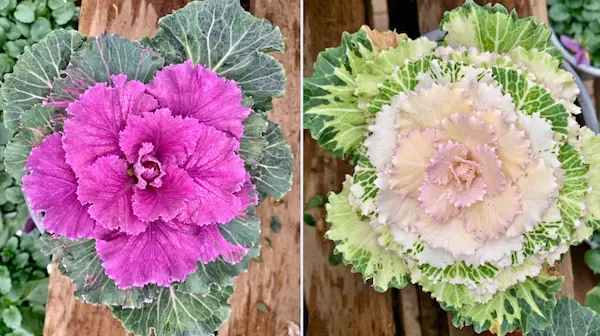
How Long Does Ornamental Cabbage Last
Once acclimated in a site, ornamental cabbages and kale can survive temperatures as low as 5°F, so plants may last well into November and December. They are considered an annual which means they will not grow back the following season. Mature healthy plants can get as high and wide as 18 inches.Ornamental Cabbage Varieties
1. Color-Up Pink Ornamental Cabbage
The Color-Up sequence of flora fall beneath the cabbage species B. oleracea. The cultivar 'Color-Up Pink' aspects minty-green leaves with a blush middle and an upright boom dependancy that appears perky in the backyard when a tough freeze has knocked the entirety else flat.2. Osaka Red Ornamental Cabbage
An outer ring of crimson leaves surrounds a bright magenta core on this beautiful decorative cabbage cultivar. These full of life flora have compact heads that attain eight inches throughout and 1 foot high. The most extreme coloration will show up when temperatures vary between 35 and forty five degrees. Purple and fuchsia leaves absolutely pop in opposition to a history of snow.3. Condor Ornamental Cabbage
The uncommon lengthy stems of the 'Condor' decorative cabbage make it a florist's favorite. Ornamental Cabbages develop up to 30 inches high, however the heads are petite and appear fine planted in organizations of eight or more. Bright inexperienced outer leaves encircle shiny white leaves with simply a trace of blush. This decorative cabbage makes a candy focal factor in the wintry weather container garden. The Condor sequence consists of crimson and white sorts as nicely as these with white-with-pink centers.4. Pigeon Red Ornamental Cabbage
The inexperienced foliage on the outer leaves of 'Pigeon Red' is improved via white veining that performs off the vivid crimson core of the plants. Sow seeds about six weeks earlier than the common first frost in your vicinity to attain giant transplants that will be garden-ready when temperatures drop.5. Pigeon White Ornamental Cabbage
The creamy white facilities of 'Pigeon White' seem like the icing on a cupcake and have simply as a good deal style enchantment to some vegetable backyard pests. Ornamental cabbage sorts like 'Pigeon White' can thrive in each spring and fall, however you may additionally have higher success warding off bugs like cabbage worms, aphids, and cutworms with a late fall planting. In addition to the purple and white varieties, the Pigeon collection additionally presents purple and crimson options.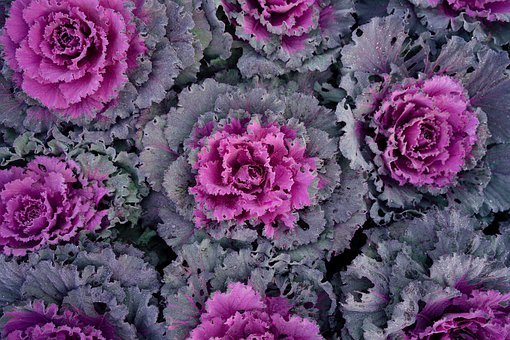
Ornamental Cabbage Benefits
Ornamental Cabbage is preferred via gardeners who favor to add some colour to their fall and wintry weather gardens and containers, as it grows properly in cooler weather. In fact, the hues turn out to be their most vivid as soon as night time temperatures begin losing under 60°F. However, these colorings will begin to fade as soon as midnight temperatures begin losing to 20°F and colder.In addition to offering a tremendously addition to your garden, you might also be thinking if there is any attainable dietary gain to these Ornamental Cabbages.
Ornamental Cabbage Care FAQs
What if Ornamental Cabbage Growing Tall
It's challenging to beat flowering cabbage and kale for drama in the fall garden. Sometimes known as decorative cabbage and kale, these daring rosettes nearly, however now not quite, steal the autumn exhibit from brightly coloured chrysanthemums and pansies.If grown from seed, flowering cabbages and kales can take from seventy five to ninety days to mature. Ornamental Cabbage have to be planted 12 to 15 inches aside and develop 12 to 18 inches tall. In fall, you can discover mature cabbages and kales in the Garden Center. Plant them in full solar or in section colour with safety from harsh afternoon sun. When planting, amend soil with natural compost. Cabbage and kale like a barely acidic to impartial soil.
Is Decorative Cabbage Edible?
Yes! Cook Ornamental Cabbage away if you would like. But you may additionally be dissatisfied with the taste. Remember that decorative veggies are bred for their brilliant colours and uncommon leaves and shapes, and no longer their flavor. In fact, I recognize decorative kale is mainly bitter.Edible kale is bred for taste. Ornamental kale has been cultivated in particular for showy foliage, so cooks have a tendency to use it as ornament in a dish than an ingredient. Ornamental Cabbage are truely edible, however they have a tendency to style a bit much less nice with a greater bitter tone than kales cultivated to eat.
Latest Updated
- Benefits of Bugleweed - 7 Science-backed Health Benefits
- Bugleweed Dangers & Side Effects - Is It Poisonous?
- How to Plant Evergreen Trees - What You Should Know
- When to Plant Evergreens - Grow Guide for Evergreen Trees
- 12 Wonderful Evergreen Shrubs for Your Garden
- 12 Popular Evergreen Plants with Pictures for Beginners
- When And How To Prune A Lilac Bush Like a Pro
- How to Grow & Care for Lilac Vine (Hardenbergia Violacea)
- Japanese Lilac Tree (Syringa Reticulata) Care & Propagation Guide
- Shumard Oak Pros and Cons - What to Know
Popular Articles
- Winter maintenance of Antirrhinum Majus
- How to Grow Terminalia Mantaly Tree
- How to Grow and Care for Crossostephium Chinense
- How to grow Antirrhinum Majus in spring
- Peristeria Elata (Dove Orchid) Profile: Info & Care Guide
- Underwatered Snake Plant (Sansevieria Trifasciata) - Signs And How To Fix
- How to Care for Brazilian Jasmine Plant (Mandevilla Sanderi)
- How to Grow & Care for Graptopetalum Purple Delight in Summer
- Rosa Chinensis (China Rose): Plant Growing & Care Tips
- How to Care for Baby Sun Rose (Aptenia Cordifolia)